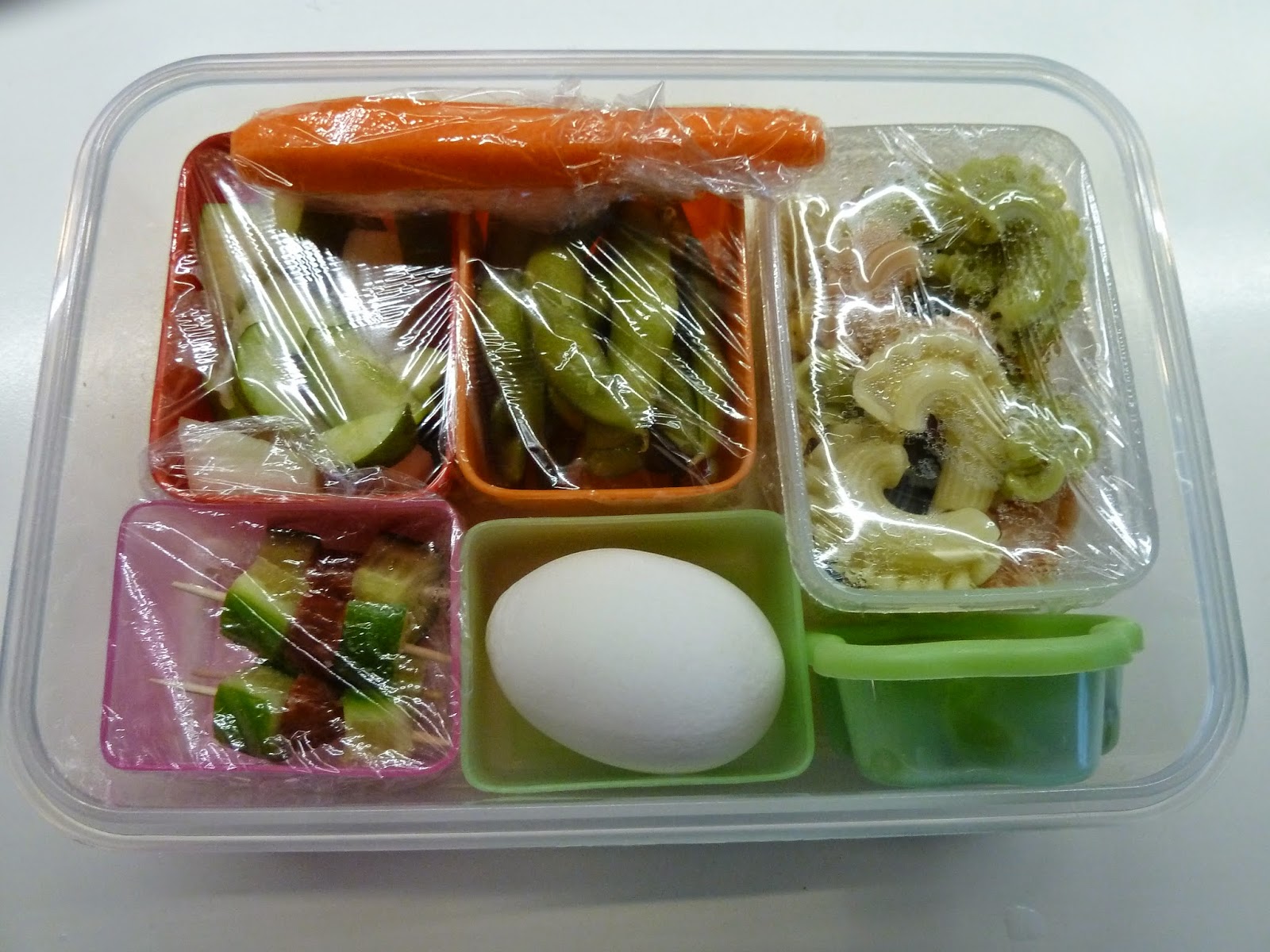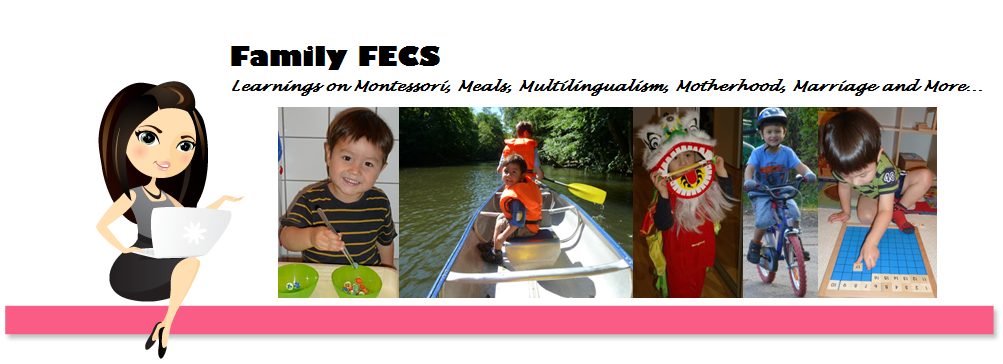My philosophy with regards to packing lunchbox:
1. Nutritional value
I try to pack according to the 7 colors of the rainbow to cover the spectum of nutrition. I prioritise food that required minimal cooking to retain its nutritional value. For example, I prioritise carrots, frozen green peas, frozen sweet corns, spinach, blueberries and nuts.
That also means that I keep to the minimum processed food such as hot dogs, sauages, salami, commercially prepared meat-balls, tuna-salad, chicken salad, etc. though it is not possible to keep them totally out, since your child is exposed to other children's lunchbox. Blueberries and walnuts are our staples, because they are believed to be good for brain development - myth or not, I subscribe to it. Goji berries is a tonic the Chinese can't live without.
I try to include only slow-burning carbohydrates such as rye bread. We like the Chia brød or the øko 1000-kernebrød from the Danish Lagekagehuset:
 |
| Rye bread Øko 1000-kernebrød 16 DKK per half loaf |
 |
| Chia brød from Lagekagehuset 19.50 DKK per half loaf |
For pasta, we try to pack more frequently the wholegrain ones, or those with spinach or black beans, because it contains more fiber or are more nutritious. Below are some of our favorite pasta. The fresh ones are available from supermarkets such as Netto, and it takes only 2-4 minutes to cook:
 |
| Fresh pasta from Netto - the green ones contain spinach |
 |
| Organic blackbean pasta available from IRMA and the organic wholegrain pasta from Netto |
For protein, I try to use fish as a staple, and it is usually salmon, because it is easily available here and for its good fats content.
For fats, instead of butter, I try to use only the good fats such as avocado, olive oil and nut butter. These can be obtained from the Danish organic store Urterhuset.
I try to use the healthier seasonings such as olive oil, salt, soya sauce, tahin (sesame dressing) and herbs such as oregano, basilicum, herbs de provence.
I also use roasted onions and home-made garlic oil or shallot oil using canola oil as seasoning - these spice any food up immediately. The homemade garlic oil or shallot oil stored in air-tight container can keep for 2 weeks.
Though keeping to the minimum, I allow some seasoning to retain the tasty factor such as salad dressing or a touch of mayonnaise (I haven't need to resort to this yet, but I am sure it will in the day to come).
2. Simplicity and time-saving
You can call me boring, but I pack the same food each day that makes up 80% of J's lunchbox. This keeps thinking (what to pack, etc.) to the minimum, and I can go on auto-pilot :-) Our 10 staple food are as follows:
1. Carrot - orange
2. Blanched broccoli or green peas - green
3. Blueberries - purple/blue
4. Red pepper bell or Goji berries - red
5. Walnuts - brown
6. Apple or pear
7. Rye bread or banana (as good source of slow-burning carbohydrates)
8. Smoked salmon (as good source of fats and protein)
9. Fish roe
10. Avocado or olive oil (as good source of fats)
Here is a picture of our 10 staple food for lunchpack:
Prioritizing food that required minimal cooking or processing also saves me time. For example, the frozen peas can be packed the day before, without any cooking needed.
3. Variety
I try to vary the meat for protein throughout the week such as canned fish mackerel, smoked salmon, saute chicken, frozen shrimps, egg, beans, pan-fried fish, etc.
 |
| With canned mackerel |
 |
| pan-fried fish with remoulade |
For carbohydrates, apart from rye bread, I vary with spelt grains, quinoa, millet, etc. which are very nutritious. I sometimes include potatoes, sweet potatoes and pumpkins. When our bananas are over-ripe, or when I have some surpus to bake, I sometimes replace the rye bread with banana oatmeal bread/buns baked with wholegrain flour.
 |
| Lunchbox with banana oatmeal fish bread |
Besides walnuts, I will also include a portion of other nuts such as pecan, hazelnuts, almonds, cashew nuts etc. and dried fruits such as raisins, fig, cranberries, etc. as snacks. However, the nuts are never salted.
For vitamins, besides the staple vegetables and fruits in J's lunchbox, depending on season, if I have the surplus energy, I will add in some other fruits such as honeydew, water melon, strawberries, mandarin orange, etc. I also add banana occasionally, although not daily.
For vegetables, I vary with baby spinach, long beans, asparagus, edamame, etc.
 |
| With frozen edamame in orange container |
Sometimes, I will include pizza or... , sandwich, etc.
 |
| Lunchbox with homemade pumpkin pizza leftover from dinner |
...sandwich style cut into halves or quarters
 |
| Sandwich style |
4. Prioritize long term benefit over short term
I look at a food's long term impact on taste-bud shaping. For example, I try not to use butter, but olive oil in the food, because of its impact over habit forming. For example, although liver paste is good, I don't pack it as frequently, because of the high cholestrol. While children are not afraid of high cholestrol, they will grow up and get hooked on the food they have always eaten during childhood. Thus, I look at the long term impact.
5. Overview with Bento-style
I find packing the small portions bento-style or tapas-style in small containers and cover with clear wrap helps to provide a clear overview. It also helps to keep the food in place during transportation. I know the downside is that you will have many small containers to wash, in addition to the lunchbox! But I can live with this downside.
Although the small containers come with lids, I prefer to wrap it up with clear wrap, as it would be more interesting to be able to see the food.
As J's kindergarten allows heating up food, when packing food which required for heating up, I use small porcelain dishes and bowls, instead of the small containers:
Air-tight jars from mini jams or fish eggs are useful to hold dips, sauces or dressings:
I use clear 1500ml air-tight container as J's lunchbox, and fit the individual containers inside it, as this gives the most flexibility. I do not recommend to buy those lunchbox that comes fixed with compartments, as you would not be able to move things around.
 |
| Without hot meal |
But most kids would prefer the cute ones. If so, you can use just the small containers and arrange them into your cute lunch box.
6. Proportion
The Danish authorities recommend a "Y" shaped "plate" for every portion, divided into 2/5 consisting of vegetables and fruit; 2/5 consisting of carbohydrates such as rice, bread, potato or pasta; and 1/5 consisting of protein such as meat, fish, egg or cheese.
Here is how I turn the above theoretical advice into ppacking lunchbox:
- 4-5 containers for vegetables and fruits
- 2 larger containers for carbohydrates such as rye bread or rice
- 1 medium container for protein such as meat, fish, chicken or egg
7. Include a challenge
If I can, I will include 1 "challenging or new food" a week such as baby spinach, ruccola, kale, basil leaves, pineapple, orange, sharon fruit, promenade, sweet potatoes, pumpkin, tomato, egg plant, beans, asparagus or karse, etc. For example, I will include a few strains of ruccola or 1 small bitesize pineapple. These will not be J's choice, but he is challenged to eat them. Through such weekly challenge, I hope he will acquire a taste for it.
8. Include a dose of culture
It can be a challenge how to keep your child's heritage, without embarrassing him in front of his friends and classmates. Kids don't want to stand out from their friends and don't like their food to look different from the average John's or Lar's (in the Danish context).
The trick is to not make the ethnic food the main part of his lunchbox, but include it in his lunchbox discreetly as part of an "annex" i.e. in small portion. For example, don't pack your kids' lunchbox full of Chinese noodle soup, but include Chinese fried rice as a smaller portion in his lunchbox.
 |
| The small porcelain dish used to contain fried rice, etc. is only a small part of the lunchbox that contains normal Danish lunch such as rye bread. |
 |
| Here is an example of how it looked when it is packed with food, including Asian and Danish food |
So far, it has worked. I am fortunate that at 5 years old, J does not feel embarrassed about eating Asian food in front of his friends. In fact, he is proud of it. Sometimes, I experienced the opposite effect - the kids at his kindergarten actually envy him for having a varied and different lunchbox, that he gets sushi in his lunchbox :-) I also include chopsticks for him as part of cultural education for his Danish classmates :-)
 |
| Lunchbox with Japanese handrolls :-) |
9. Include a dose of love
Occasionally, I leave a note in J's lunch box from Daddy or me to tell him I love him or to surprise him.
 |
| A little card for J in his lunchbox :-) |
Parents pack their kids' lunch box with love and it will come through from the lunchbox, no matter how humble your lunchbox is. It will be a memory for your child in years to come.
10. Include a treat
Although not everyday, I try to include something that J loves as a treat such as biscuit, cheese stick, rice biscuit, dried fruit, museli bar or pizza. So far I don't have to resort to include sweets, chocolate, cookies or cakes (and I hope that day will never come).
 |
| With J's favorite cheese stick |
 |
| Lunchbox with fish fingers |
11. Include a dose of fun
Although packing lunchbox should be practical and not time-consuming, occasionally, it can be fun to make those cute and pretty Japanese lunchbox. Once in a while, I will make something pretty such as cutting the carrots into flower-shaped, but this is not necessary.
 |
| Sleeping teddy bears... I know, it doesn't look so pretty like those gorgeous Japanese ones, but it was fun for me to make them :-) |
12. Post your lunchbox
Packing lunchbox can be very mundane, and despite my best efforts, I find J's lunchbox slipping into pathetic state. When this happens, it will be time to pull up my socks and buck up. And I find that it helps me to motivate myself, if I post the lunchbox.
You can find J's lunchboxes here:


